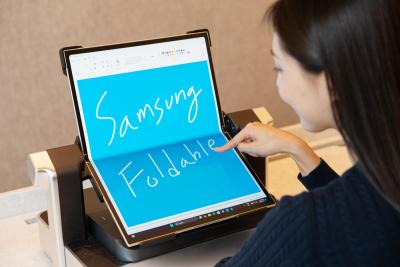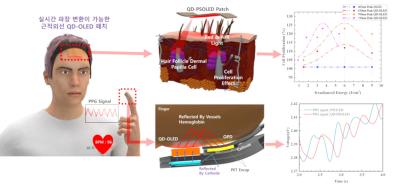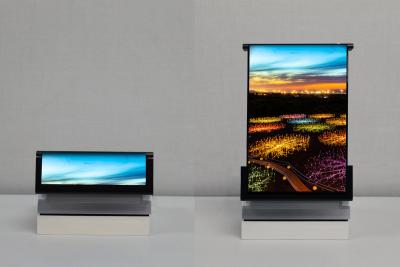Flexible OLEDs: introduction and market status
OLED is an emerging display technology that enables beautiful and efficient displays and lighting panels. OLEDs are already being used in smartphones, laptops, wearables, tablets and TVs, and many of OLEDs are flexible ones.

A flexible OLED is based on a flexible substrate (usually polyimide). The first generation of OLEDs produced on these were not really flexible from the user perspective. The device maker bends the displays, or curves it - but the final user is not able to actually bend the device. These first-gen flexible OLEDs are adopted many premium smartphones, for example the Samsung edge-type Galaxy phones or Apple's latest iPhones. A plastic-based OLED has several advantages especially in mobile devices - the displays are lighter, thinner and more durable compared to glass based displays.
Second generation flexible OLED displays can be bent by the user - these can be used for example to create foldable smartphones - the first range of which started shipping in 2019 and today these are quite popular. Rollable OLEDs are likely to enter the market soon, offering the ability to create scrollable devices. In 2019, LG launched the world's first rollable OLED device - the 65" Signature OLED TV R but in 2024 it discontinued this device as its price was too high for consumers.

Where to buy flexible OLEDs?
While several companies (including Samsung, LG, BOE and others) are producing OLED displays, it is not straightforward to find a good and reliable supply of these displays.
If you are interested in buying a flexible OLED panel for your project or device, look no further. Our OLED Marketplace offers several flexible OLEDs, which can be ordered through us with ease.
Researchers use graphene to create more effective flexible OLED laser lift off process
Researchers from the Korea 's SNU, KAIST and KIMM developed a new lift-off process for flexible OLED displays, based on graphene. The researchers term the new method GLLO, or Graphene Laser Lift Off.
The researchers placed a single-layer CVD graphene film between the polyimide film and the glass carrier. The graphene, with its ability to absorb ultra-violet light and distribute heat laterally, enables a clean lift-off without any wrinkles or residues. Using the GLLO method, the researchers successfully separated 2.9 μm thick ultrathin PI substrates without any mechanical damage or carbon residue left behind. In contrast, traditional methods left the substrates wrinkled and the glass carriers unusable due to stubborn residues. This breakthrough has far-reaching implications for stretchable electronics and wearable devices.
Samsung Display to start producing rollable OLED laptop displays in April 2025, Lenovo is its first customer
Samsung Display unveiled a 18.1" rollable OLED laptop display at CES 2025, one that can roll down to 13.1" when closed. The company today announced that it aims to begin mass producing rollable OLED displays in April 2025. This will mark the first ever mass produced rollable display (apart for the limited volume production of LG's 65" rollable TV screens, that are discontinued).
During CES, Lenovo demonstrated the first laptop to use such a rollable OLED, the ThinkBook Plus G6 Rollable laptop. Lenovo plans to launch it globally in June 2025. The ThinkBook Plus G6 Rollable will have a 14" 5:4 display when rolled in, and a 16.7" 8:9 display when opened. That's an increase of almost 50% in screen size. The price of Lenovo rollable laptop will start at $3,499 - this is a ultra premium device.
LG Display to retrofit its iPad AMOLED line to produce iPhone OLEDs as Apple reduces its tablet display orders
In late 2024 we reported several times that demand for Apple's iPad Pro devices is lower than expected, and the company reduced its OLED panel orders from both Samsung and LG.
According to a new report from Korea, LG may decide to start using its IT AMOLED production line to produce smartphone displays. The company looks to supply 70 million iPhone AMOLED displays to Apple in 2025, up from around 65 million in 2024 (and 52 million in 2023). Converting the IT AMOLED line to smartphone panel production will enable LGD to increase capacity without a large investment in new equipment.
Samsung Display shows new OLED technologies at CES 2025
Samsung Display is set to show new OLED technologies at CES 2025, including new foldable display, rollable ones, automotive displays, next-gen QD-OLED panels and more.
So first up, Samsung will be showing a 18.1 foldable OLED display (which it says is the world's largest). This panel is suitable for IT devices - to enable devices that combine tablet, laptop and monitor devices into one. When folded, this display is 13.1" in size.
Researchers use a high-output flexible QD-OLED patch to encourage hair growth
Researchers at Korea's Gachon University, in collaboration with InnoQD and researchers from Chungbuk National University, have developed a new QD-OLED patch that can encourage hair growth. The patch can also measure heart rate at the same time.
The researchers used a flexible OLED device, and covered it with quantum dots that emit near-infrared (NIR) light. The OLED device is a tandem blue OLED device, that offers a high light output. The researchers say that when attached to the head, the patch encourages hair collicle cell growth, with a measured improvement of 23% in hair growth.
Ares Materials announces an investment with Denka to bring its films and materials to the flexible OLED industry
US-based Ares Materials announced that it Japan's Denka invested in the company, with an aim to expand its high-functional materials business. Denka invested via its corporate VC that is jointly managed with Pegasus Tech Ventures.
Ares Materials developed a design technique that utilizes materials informatics (AI) for using enethiols as a raw material and possesses the technology to produce high-performance optical films using the design technique. The company says its optical films offer high performance, low cost and a reduced environmental impact.
Inuru's flexible OLED holo tags - hands on review
A few months ago Inuru started shipping its range of OLED-powered stickers, or "holo tags" as the company refers to them. These are battery-powered flexible stickers that can be used for laptops or any other use.
The company was kind enough to send us three stickers, from their latest Cyberpunk range. These stickers cost around 20 Euros, and there are many alternative designs. The idea is that the flexible stickers include a small OLED, a battery and a button that lights up the OLED for a few seconds. The whole device is said to be waterproof, but I did not test it.
Inuru says that the lifetime of the OLED is about 5,000 hours. As the battery is limited, though, they say that each sticker is limited at around 2,500 clicks. Some of them use a red OLED, and some a blue one.
BOE and Omniply to co-develop materials and processes for flexible display manufacturing
BOE Technology Group and Canada-based Omniply Technologies announced a co-development agreement, with an aim to develop new materials and process technologies for display manufacturing.
It turns out that the two companies have been working together for almost 2 years, hoping to bring Omniply's technology into BOE's next-generation flexible OLED fab. BOE hopes that Omniply's technology may enable lower cost production of OLED displays, and the production of more eco-friendly displays. It also has the potential to be used in flexible sensors and microLED products in the future.
Reports suggest Samsung is accelerating its rollable smartphone project, aiming to launch it in 2025
According to a report from Korea, Samsung is progressing with its rollable OLED development project, and the company aims to launch its first rollable smartphone in 2025. When fully opened, the phone will sport a very large 12.4" display. Interestingly, Samsung apparently will implement an under-the-display camera solution.
Samsung's acceleration of its rollable phone project is seen as the Korean device maker's response to Huawei's tri-folding smartphone, the Mate XT. It is seen that this was an embarrassment for Samsung, that recently also to witness LG Display's leading over it with tandem OLED production. It will remain to be seen whether Samsung's acceleration will lead to problems in quality and reliability - which happened when it launched the world's first foldable phone back in 2019.
Researchers from Korea develop high performance stretchable OLEDs based on rigid 3D islands and horseshoe connectors
Researchers from Korea's KAIST, in collaboration with Dong-a University and ETRI have developed a new stretchable OLED structure that is made from 3D rigid islands, or bumps. These so-called 3D-Pop islands remain unchanged as the display itself stretches and so maintain excellent performance.
The OLED islands are connected with parts that are curved in shape (similar to a horseshoe) that can be deformed while still operating normally, even at 500% tension. The whole structure can simultaneously utilize hinge-type rotation and tension of the bending connection connector, and is so not limited to a 2D plane. Even at 40% elasticity, the light emitting area remains at 85%.
Pagination
- Page 1
- Next page











